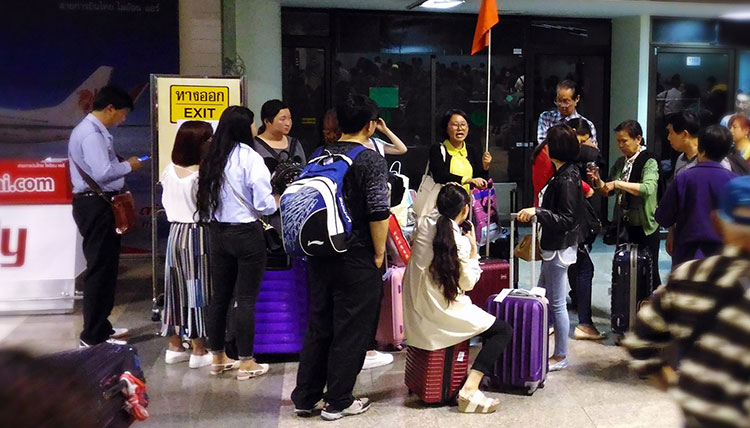
TICA MICE UPDATE
VOL: 41 SEPTEMBER-OCTOBER 2016

TOURISM
THAILAND’S TOURISM GREW IN THE FIRST NINE MONTHS OF 2016
According to Mr. Yuthasak, in the first nine months of 2016, Thailand’s tourism industry is expected to generate a total of 1.88 trillion Baht (US$53.7 billion)
for the Thai economy, representing a year-on-year increase of 14 per cent.
Of the total, some 1.25 trillion Baht (US$35.7 billion, up 17 per cent) has been raised by 24.94 million inbound tourists (up 13 per cent) and another 629
billion Baht (US$18 billion, up 6 per cent) has come from domestic tourism with 111 million trips having been taken by locals (up 4 per cent on last year).

Thanks to TAT’s aggressive international marketing campaigns, Thailand has continued to record impressive growth in the international tourist markets
with Northeast Asia being the largest at 17 per cent, the Americas at 15 per cent, ASEAN, South Asia and Europe at 10 per cent each, the Middle East at 8
per cent, and Africa at 5 per cent each.
The Oceania market recorded a 1.25 percent growth in the third quarter, bringing the overall performance up slightly, though there was a 0.7 per cent
drop across the 9-month period.Going forward, to the last quarter of 2016, TAT expects Thailand to generate 698 billion Baht (US$20 billion, up 16 per cent),
comprising 468 billion Baht (US$13.4 billion, up 19 per cent) from 9.01 million tourists (up 15 per cent) and 230 billion Baht (US$6.6 billion, up 9 per cent) from
domestic tourism with 42 million trips expected to be taken by locals (up 7 per cent) as the cooler weather arrives.

Other contributing factors to the growth prospects for the October to December period, 2016 include the fact that Thailand is entering the high season
with forward bookings for air travels to Thailand already showing an 8 per cent increase.
There are also new air links that have been established, including those from Russia (Moscow, Vladivostok and Yekaterinburg), the Middle East
(Tehran, Dubai and Doha), and Asia (Hong Kong, Mandalay, Luang Prabang and Vientiane).

In addition, in the days either side of the National Day of the People’s Republic of China or Golden Week, as it is known, from 1 to 9 October, a total of
39 chartered flights with 7,594 seats have confirmed services to Bangkok and Phuket from nine cities in China.
The TAT’s statement of confidence is shared by representatives from the TCT, ATTA, THA and K-Research, and their independent statistics confirm
growth in the first nine months of 2016 with several contributing factors signaling that this growth is set to continue in the final quarter of the year.

TCT’s tourist confidence index which stood at 98 in the third quarter is expected rise to 102 in the fourth quarter (the normal index is around 100)
while ATTA, which handles one sixth of the total tourist arrivals to Thailand is expecting to welcome 6.3 million tourists this year, up from 5.12 million
last year.
Officials in Thailand are working to help the tourism industry in several provinces affected by deadly bombings earlier this month.
Ministry of Tourism and Sports reports international visits to Thailand exceeded 19.53 million, an improvement of 11.87% during January to July, this year.
Released last week, the ministry’s data showed the country attracted 19,538,190 international visits during the first seven months of this year, compared to
17,465,861 visits during the same period last year.
Bombings in several southern provinces killed or wounded more than 30 people, including foreigners.

Experts say more attacks could have a deeper effect on the industry, which is very important to the country’s economy.
Economists at the University of the Thai Chamber of Commerce say the attacks may cause up to 365,000 fewer people to visit the provinces.
And they estimate the areas could lose $170 million in revenue.
Tourism and Sports Minister, Kobkarn Wattanavrangkul, commented:
“The country remains a very popular destination…we are not just focusing on the Chinese, but all markets such as Europe, the Middle East and ASEAN.”
In July alone, foreign travellers recorded 2,946,286 visits, an increase of 10.85% from 2,657,993 visits during the same month last year.
The World Travel and Tourism Council says tourists spend $72 billion a year in Thailand. The industry directly or indirectly employs about five million
people. That is more than 14 percent of all jobs in the country.
The kingdom is even going ahead with a doubling of the Visa On Arrival fee to 2,000 baht ($58) which the Thai Cabinet had approved in January. Coming into
effect on September 27, it applies to visitors from 19 countries, including China, by far Thailand’s largest source market with close to 8 million arrivals
last year.
Officials expect about 33 million people to visit Thailand this year. They say about 30 percent of them will come from China.



